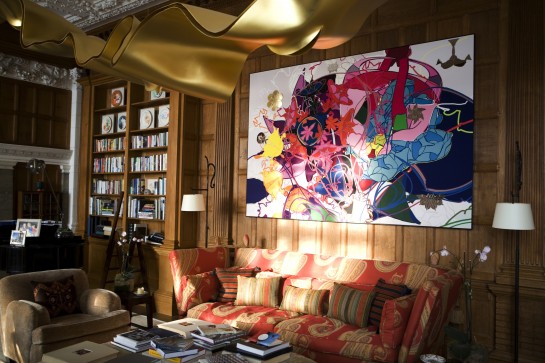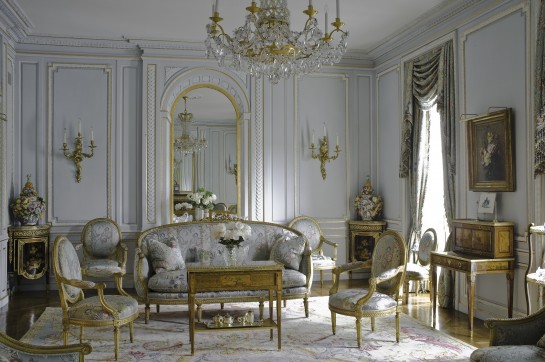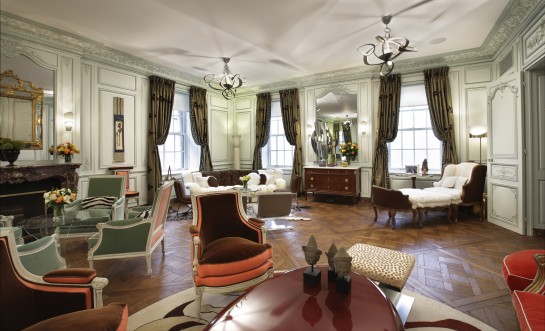I’ve been incredibly lucky working in the interior design industry, and have had the opportunity to meet many talented people. But I’d never had the pleasure of meeting Robert Couturier, until last week.
We’ve long been Facebook friends, and here on the blog we humbly count him among our readers. I messaged him and asked if he might be interested in an interview – he agreed and graciously invited me for an afternoon chat. We talked about the ups and downs of decorating in the age of the internet, about how 1st Dibs has impacted the industry, and about his favorite contemporary architects. He also shared some images that represent the scope of his formidable portfolio.
Having started in interior design in 1981 working for Adam Tihany, Couturier struck out on his own in 1987, and has fashioned an incredibly successful career which shows no signs of slowing up. He employs a staff of 20 designers and architects in an expansive office loft in New York City’s Soho neighborhood, and lives in a loft on the floor above that is one of the most beautifully decorated spaces I’ve ever seen. If you missed it when it was published you can see the images here courtesy of Elle Decor.
In our Master Class column we endeavor to gain insight from the greats in our industry, and to that end in this weeks installment Robert Couturier does not disappoint. Here’s an excerpt of our conversation.
.
So much has changed since the advent of the internet. How do you think interior decoration has fared in the digital age?
The internet has made most information available to everyone, professionals and non-professionals alike. It has also broadened widely the fields of research – information that used to take weeks to travel takes mere seconds now. Only 15 years ago antique dealers expected photos of furniture to be returned to them, which today would be inconceivable since they are all downloaded from the internet. The internet has done more to transform the world into a global marketplace than anything else, with its flaws and its advantages. It is a tool not a guide. However on a certain level it is allowing everybody to be a decorator.
.
You bring up the subject of antiques, I’m curious. What sort of impact do you think 1st Dibs has had on our industry?
1st Dibs is obviously a fantastic resource. But like the internet it has made all information available to everyone, again professionals and non professionals. It presents elements of decoration on the same level, without explaining why one piece is $100 at one dealer and $1,000 at another – which is daunting for a non professional and consequently favors the lowest denominator. 1st Dibs has actually and effectively cut the decorator out, and allowed clients direct access to sources that used to be only open to the trade. It is not bad in and of itself, but it has cheapened the antique business while at the same time allowing it to develop tremendously.
.
Do you agree that architecture has been positively effected by the information age?
Well it has allowed, through technology, an infinite world of possibilities and has boosted creativity to an incredible degree: Frank Gehry, Zaha Hadid or Calatrava would not be able to create their fantastic forms without these technical advances. I also think the information age and globalism are in the process of giving the world one common aesthetic. It is increasingly difficult to recognize one modern city from the next. I think that a global vision is increasingly applicable to decoration as well: modern apartments in Shanghai, Bombay, New York or London, to a large extent, all look the same – and in various degrees look more or less like fancy hotel rooms.
.
I’ve been watching the magazine industry change as digital content sources grow in numbers. What do you see as the future of print media?
That’s difficult to say. I think the world is becoming more and more one where the rich are becoming richer, the poor poorer and the middle classes squeezed in the middle. Shelter magazines that used to cater to a formerly affluent middle class have to now cut their costs and therefore are going on line. I think the very rich will always love their glamorous magazines, although I might be wrong. We might all soon read magazines with our Ipads, which might not be a bad idea in a world where trees are fast disappearing.
…………………………
I’d like to say a special thank you to Robert for being gracious with his time and for sharing some of his perceptions of the current state of our industry. If you’re interested in seeing more of his work, his company website has many projects for you to view. You can also follow him on his social media outposts.
…………………………
Robert Couturier Inc.
Facebook Twitter Pinterest LinkedIn
.
Written by CJ Dellatore





